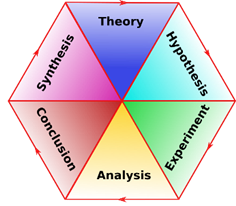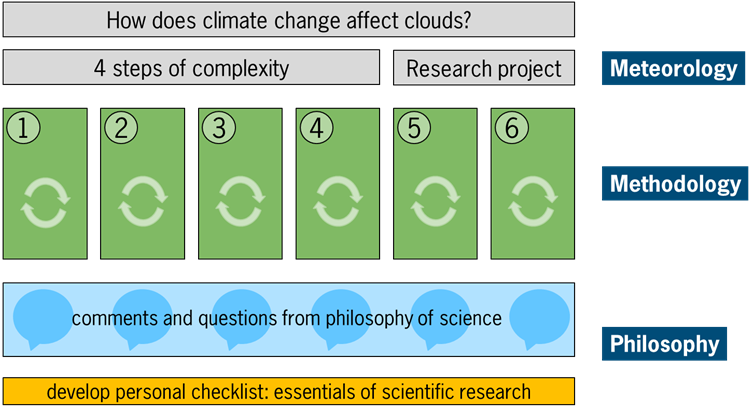Development and organization of the course
Development

The depiction of the research cycle as used throughout the course.
The course intends to connect thinking and reflecting about the scientific method (depicted in the figure to the right). with practicing it in a virtual research laboratory.
Originally, the course was envisioned as a modular course with three distinct parts: a generic part about the scientific method and philosophy of science, a domain specific part in which students where guided in practicing the scientific method, and a virtual laboratory that was needed to perform research in.
However, in the first pilots with students, it became clear that this setup did not work well, because students were not able to see the connection between the various elements:
- between knowledge about science as an activity and philosophy of science
- between philosophy of science and the scientific method
- between philosophy of science and the knowledge of their own domain
This has made us reconsider the setup radically. We decided to interweave the various aspects much more tightly. We realised that this stronger integration would endanger the intended modularity of the course. However, the course would gain in relevance to the students.
Setup of the course

Overview of the structure of the course.
In the figure to the right the setup of the course is sketched. The course consists of six modules. In each module three aspects are combined:
- Philosophy of science: this entails both the historic context of the development of the scientific method (research cycle) and reflection by the students on their own role in science (through a personal science checklist)
- Methodology: this entails the logic of the research cycle, as well as various generic scientific concepts as causality, feedbacks, validation and uncertainty.
- Domain knowledge: the meteorology in the lower part of the atmosphere is used as the context in which philosophy of science and methodology are applied. An overarching research question connects the six modules
In the first four modules the students work on all three aspects in an integrated way. In each module they traverse the research cycle which is our interpretation of the scientific method. From module one to module 4 the emphasis shifts along the various steps in the research cycle. Furthermore, the degree to which the students are directed in their research gradually decreases from module 1 to module 4.
To enable the students to develop and train their mastery of the scientific method, we provide them with a virtual laboratory in which they can perform their research. Initially, the intention was to develop a new online virtual laboratory, based on a conceptual model that we already use for education. However, along the way it was decided to use the downloadable version of the model as it turned out that it worked equally well in combination with the online course.
In the last two modules the students work on their own research project. In module 5 they develop their research project and describe that in a research proposal. In module 6 the students perform the actual research and describe their research and findings in a short report. In addition, they reflect both on their methodology and on their own research process vis-a-vis their personal science checklist.
In all modules, mutual exchange between the students forms an essential part. This entails the regular use of discussion fora where students post their thoughts and findings, and provide each other feedback. In addition, in modules 5 and 6 peer feedback on the proposal and report is used as a way to improve the quality of the products and to train the students in their reflective skills.
A full description of the design of the course, as well as information on how to adapt the course, can be found in the >Course Manual
Practical implementation
The course has been implemented in EdX-Edge to allow the course to be used both within the university and outside (as part of education at other universities, summer schools etc.). The work load of the course is 3 EC, roughly divided equally over the six modules.
At Wageningen University the course is used within a blended course Learn the Scientific Method in a changing climate which runs for 6 weeks. The online course is supported by a weekly class-room session of about 1 hour. This meeting is mainly devoted to continuing some of the online discussions and clarifying certain concepts. Furthermore, practical and organizational issues. The course is supported by a Brightspace course (the standard Electronic Learning Environment at Wageningen University). Brightspace is used for communication with the students about practical matters related the course (both through e-mail and via a discussion forum). Furthermore, the Brightspace course is used to hand-in the proposal and report, and for the administration of the grading.
Re-use
The course has been developed with re-use in mind. The first method of re-use we envision is that the domain-related part (both the theoretical background and the virtual laboratory) could be replaced by theory and a laboratory from another domain. Furthermore, there are a number of learning paths that could be used separately as part of other courses. These paths are:
- philosophy of science related to the scientific method
- the personal science checklist through which students reflect on their own principles related to scientific research
- the scientific method itself
- the theory on the atmospheric boundary layer and cloud formation (domain-specific)
These learning paths have been interwoven within the course to optimally make the connection. However, at the same time they can easily be identified, based on the icons that are used in the course. The structure is analysed in a spreadsheet that may serve to disentangle the learning paths.